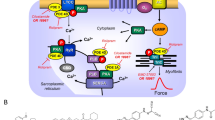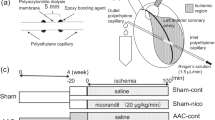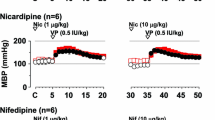Summary
The antifibrillatory, antithrombotic and hemodynamic properties of intraventricular prostacyclin (PGI2) application were studied in a conscious canine model of sudden cardiac death. In anesthetized dogs, a wire electrode was implanted into the left circumflex coronary artery (LCX) and acute myocardial ischemia was produced by 90 min occlusion of the left anterior descending coronary artery (LAD) followed by reperfusion. An intracardiac pressure transducer measured ventricular pressure, heart rate, filling pressure and dP/dt. The ECG was obtained from subcutaneous chest needles. Six days later while in ambulatory state, a 180 μA DC current was applied for 4 h to the LCX intimal lining in Tris-HCl (n=10) and PGI2-treated dogs (50 and 100 ng/kg/min, 11 and 12 dogs, respectively).
Myocardial injury and coronary thrombosis induced by electrical stimulation produced ventricular fibrillation in all vehicle-treated dogs at 145±33 min (mean±S.D.). In PGI2-treated hearts only 2 animals fibrillated at 150±29 min and 180±52 min following 50 and 100 ng/kg/min of the prostanoid, respectively. Thus, 18/23 PGI2-treated dogs survived 4h electrical stimulation of the artery.
Within the LAD perfusion zone infarction was observed of equal volumes in vehicle and PGI2-treated animals. No ischemia occurred distal to the LCX coronary thrombosis. Ventricular pressure fell in all groups. Heart rate increased in the controls and those animals treated with 50 ng/kg/min PGI2 while 100 ng/kg/min PGI2 increased heart rate by 22±5% (p<0.05). Filling pressure increased in controls but fell in the PGI2-treated hearts.
The results indicate that PGI2 can prevent ventricular fibrillation resulting from acute ischemia at a site distant to previous myocardial ischemia with superimposed intimal injury and coronary thrombosis. The PGI2 properties are due to prevention of coronary thrombosis and the occlusion of the artery. Antifibrillatory effects of the prostanoids are suggested.
Similar content being viewed by others
References
Kannel WB, Thomas HR Jr (1982) Sudden coronary death: The Framingham study. Ann NY Acad Sci 382:3–21
Schuster EH, Bulkley BH (1980) Ischemia at a distance after acute myocardial infarction: a cause of early postinfarction angina. Circulation 62:509–515
Naccarella FF, Weintraub WS, Agarwal JB, Helfant RH (1984) Evaluation of “ischemia at a distance”: effects of coronary occlusion on a remote area of left ventricle. Am J Cardiol 54:869–874
Friedman M, Manwaring JH, Rosenman RH, Donlon G, Ortega P, Grube SM (1973) Instantaneous and sudden deaths. Clinical and pathological differentiation in coronary artery disease. J Am Med Ass 225:1319–1328
Patterson E, Holland K, Eller BT, Lucchesi BR (1982) Ventricular fibrillation resulting from eischemia at a site remote from previous myocardial infarction. A conscious canine model of sudden coronary death. Am J Cardiol 50:1414–1423
Johnston KM, MacLeod BA, Walker MJA (1983) Effects of aspirin and prostacyclin on arrhythmias resulting from coronary artery ligation and on infarct size. Br J Pharmac 78:29–37
Romson JL, Haack DW, Abrams GD, Lucchesi (1981) Prevention of occlusive coronary artery thrombosis by prostacyclin infusion in the dog. Circulation 64:906–914
Kettler D, Braun U, Cott LA, Heiss HW, Hensel I, Martel J, Paschen K, Bretschneider HJ (1971) Kombination von Piritramid und N2O — ein neues Narkoseverfahren. Teil I: Tierexperimentelle Untersuchungen. Z prakt Anästh 6:329–338
Romson JL, Haack DW, Lucchesi BR (1980) Electrical induction of coronary artery thrombosis in the ambulatory canine: a model for in vivo evaluation of anti-thrombotic agents. Thromb Res 17:841–853
Romson JL, Bush LR, Haack DW, Lucchesi BR (1980) The beneficial effect of oral ibuprofen on coronary artery thrombosis and myocardial ischemia in the conscious dog. J Pharmacol Exp Ther 215:271–278
Hosko MJ, Gross GJ, Warltier DC (1977) Technique for precise, graded arterial stenosis and occlusion. Basic Res Cardiol 72:651–659
Elsinga WE, Skinner DB (1975) Hemodynamic characteristics of critical stenosis in canine coronary arteries. J Thorac Cardiovasc Surg 69:217–222
Sandritter W, Jestädt R (1958) Triphenyltetrazoliumchlorid (TTC) als Reduktionsindikator zur makroskopischen Diagnose des frischen Herzinfarktes. Verh dtsch Ges Pathol 41:165–170
Schaper J, Schaper W (1983) Reperfusion of ischemic myocardium: ultrastructural and histochemical aspects. J Am Coll Cardiol 1:1037–1046
Miura M, Thomas R, Ganz W, Sokol T, Shell WE, Toshimitsu T, Kwan AC, Singh BN (1979) The effect of delay in propranolol administration on reduction of myocardial infarct size after experimental coronary artery occlusion in dogs. Circulation 59:1148–1157
Liberthson RR, Nagel EH, Hirshman JC, Nussenfeld SR, Blackbourne BD, Davis JH (1974) Pathophysiologic observation in prehospital ventricular fibrillation and sudden cardiac death. Circulation 49:790–798
Reichenbach DD, Moss NS, Meyer E (1977) Pathology of the heart in sudden cardiac death. Am J Cardiol 39:865–872
Ruskin JN, DiMarco JP, Garan H (1980) Out-of-hospital cardiac arrest: electrophysiologic observations and selection of long-term antiarrhythmic therapy. N Engl J Med 303:607–613
Lown B, Kosowsky BD, Klein MD (1969) Pathogenesis, prevention, and treatment of arrhythmias in myocardial infarction. Circulation 39/40 (Suppl IV):261–267
Holland K, Patterson E, Lucchesi BR (1983) Prevention of ventricular fibrillation by bretylium in a conscious canine model of sudden coronary death. Am Heart J 105:711–717
Chiba S, Malik KU (1980) Mechanism of the chronotropic effects of prostacyclin in the dog: comparison with the action of prostaglyndin E2. J Pharmacol Exp Ther 213:261–266
Hintze TH, Kaley G (1984) Ventricular receptors activated following myocardial prostaglandin synthesis initiate reflex hypotension, reduction in heart rate, and redistribution of cardiac output in the dog. Circ Res 54:239–247
Kowey PR, Verrier RL, Lown B (1982) Effects of prostacyclin (PGI2) on vulnerability to ventricular fibrillation in the normal and ischemic canine heart. Eur J Pharmacol 80:83–91
Jones CE, Beck LY, DuPont E, Barner GE (1978) Effects of coronary ligation on the chronically sympathectomized dog ventricle. Am J Physiol 235:H429-H434
Jennings RB, Reimer KA (1983) Factors involved in salvaging ischemic myocardium: effct of reperfusion or arterial blood. Circulation 68(Suppl I):125–136
Manning AS, Hearse DJ (1984) Reperfusion-induced arrhythmias: mechanisms and prevention. J Mol Cell Cardiol 16:497–518
Jugdutt BI (1981) Effect of PGE1, PGE2 and PGI2 on ventricular arrhythmias during myocardial infarction in conscious dogs: relation to infarct size. Prostagland Med 7:431–455
Lefer AM, Ogletree ML, Smith JB, Silver MJ, Nicolaou KC, Barnette WE, Gasic GP (1978) Prostacyclin: a potentially valuable agent for preserving myocardial tissue in acute myocardial ischemia. Science 200:52–54
Jørgensen L, Haerem JW, Chandler AB, Borchgrevink CF (1968) The pathology of acute coronary death. Acta Anaesth Scand 29(Suppl):139–199
Jørgensen L (1969) The role of platelet embolism from crumbling thrombi and of platelet aggregates arising in flowing blood. In: Sherry S, Brinkhous KM, Genton E, Stengle JM (eds) Thrombosis. National Academy of Sciences, Washington, pp 506–533
Haerem JW (1971) Sudden coronary death: the occurrence of platelet aggregates in the epicardial arteries in man. Atherosclerosis 14:417–432
Haerem JW (1974) Platelet aggregates and mural microthrombi in the early stages of acute, fatal coronary disease. Thromb Res 5:243–249
Fiedler VB, Mardin M (1985) Prostacyclin on coronary thrombosis and myocardial ischemia in conscious canine experiments. Arch int Pharmacodyn (in press)
Coker SJ, Parratt JR, Ledingham IMcA, Zeitlin IJ (1981) Thromboxane and prostacyclin release from ischaemic myocardium in relation to arrhythmias. Nature New Biol 291:323–324
Author information
Authors and Affiliations
Rights and permissions
About this article
Cite this article
Fiedler, V.B., Mardin, M. Prostacyclin prevents ventricular fibrillation in a canine model of sudden cardiac death. Basic Res Cardiol 81, 40–53 (1986). https://doi.org/10.1007/BF01907426
Received:
Issue Date:
DOI: https://doi.org/10.1007/BF01907426




